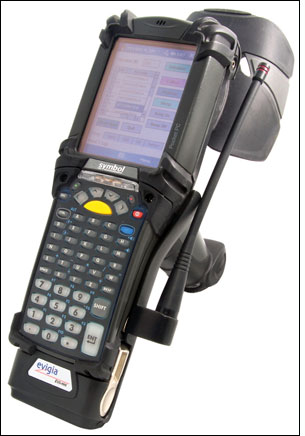Apr 14, 2010Evigia Systems, a provider of active RFID technology that sells largely to the U.S. Department of Defense (DOD) and its vendors, as well as to companies in the cold chain and logistics industries, has announced a new handheld RFID reader that combines active, passive and bar-code reading capabilities. The EV3-HHI-PAB device is based on Motorola's MC9090-G RFID handheld computer that comes with an integrated passive RFID interrogator complying with the ISO 18000-6c and EPC Gen 2 standards, as well as a bar-code scanner.
"All of the passive aspects of the Motorola reader remain the same," says Evigia's CEO, Navid Yazdi. "We added our active reader module and developed software to handle all the features, which include the ability to scan bar codes, read passive and active tags, and filter, collect and store the data to a database, or to active tags' memory." The device can also encode data to ISO 18000-6c/EPC Gen 2 passive tags.
Yazdi says he knows of no other handheld device currently on the market that combines active, passive and bar-code technologies. Evigia, he adds, developed the product with the DOD and its vendors in mind. The DOD employs bar codes, as well as active and passive RFID technologies, as tools for tracking materiel, as part of its In-Transit Visibility (ITV) Network. The EV3-HHI-PAB's active tag technology, originally developed by Savi, is licensed to a number of tag and reader providers, including Evigia, and has been standardized under the International Standards Organization as ISO 18000-7. Evigia is also a member of the Dash7 Alliance, an industry collaboration that is developing applications for wireless sensor devices based on the ISO 18000-7 standard, for use in military, commercial and consumer applications.
The Department of Defense has been adding a requirement to its vendor contracts for nearly five years, mandating that vendors attach passive RFID tags to all shipments of goods they sell to the DOD. The vendors also use bar-code labels to identify goods, and DOD cargo containers are often identified and tracked using active ISO 18000-7 tags. The EV3-HHI-PAB will enable users to take advantage of all three technologies in a single device.
The EV3-HHI-PAB can be linked to the ITV Network through connectivity software sold separately, Yazdi notes. End users shipping temperature-sensitive goods, he says, can also utilize it to read passive RFID tags attached to cases or pallets of goods, as well as collect temperature history information stored on active RFID tags with integrated sensors. What's more, Yazdi indicates, companies that employ ISO 18000-7 electronic seals (e-seals)—used to secure shipping containers, and to alert users to any evidence of tampering—could benefit from using the handheld device to track cargo within the containers, as well as read information stored on the e-seals.
The addition of the active reader module and antenna to Motorola's handheld computer, Yazdi says, does not significantly impact the device's battery life. "It will operate for anywhere from four to eight hours, depending on how it's being used," he states. "The addition of the active reader makes only about a 10 percent impact on the Motorola battery, because the ISO 18000-7 protocol is designed to be very low-power."
According to Yazdi, the active reader has a range of up to 300 feet.
Evigia will demonstrate the EV3-HHI-PAB in Booth 748 at RFID Journal LIVE! 2010, being held this week in Orlando, Fla. The company has not yet released the price of the device.


